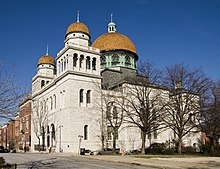Temple Oheb Shalom (Baltimore, Maryland)
Temple Oheb Shalom (Hebrew; Lovers of Peace) is a Reform synagogue in Baltimore, Maryland. The highest point in the city is located in its parking lot.
History[]
The congregation was founded in 1853 by Jewish immigrants from German Confederation member states, Hungary, and Czechoslovakia;[1] pioneer Reform rabbi Isaac Mayer Wise had considerable influence in the congregation's establishment.[2] Its first home was on Hanover Street near Camden Yards.[3]
Benjamin Szold was rabbi from 1859 to 1892; his daughter Henrietta Szold was the founder of Hadassah.[3] Szold had a moderating effect on the march of Oheb Shalom toward Reform practice. He encouraged Sabbath observance and replaced Wise's Minhag America with his own traditional Abodat Yisroel siddur.[4] William Rosenau succeeded him (1892-1940).[5][6]
In 1892 the congregation built the Eutaw Place Temple, designed by architect Joseph Evans Sperry who modeled it after the Great Synagogue of Florence in the fashionable Moorish Revival style.[3] The congregation sold the building to the Prince Hall Masons in 1961.[7]
In 1953 the congregation acquired land in Pikesville, and finished construction on its present building on Park Heights Avenue, designed by Sheldon I. Leavitt with consulting architect Walter Gropius in 1960.[3][8] The design is dominated by four large vaults and Gropius saw the design as a modern combination of "the turbine with the Torah."[9] Gropius' design also had an atypical design, with the sanctuary floor ascending toward the bimah on the eastern wall; this design was later reversed so that the floor descends toward the bimah on the western wall.[10]
References[]
- ^ "Czech Torahs Recovered After Holocaust to Reunite". Jewish Times. Retrieved 2019-04-27.
- ^ Kerry M. Olitzky, The American Synagogue: A Historical Dictionary and Sourcebook (Greenwood Publishing Group, 1996), ISBN 978-0313288562, pp. 165–167. Excerpts available at Google Books.
- ^ a b c d "History" Archived 2011-10-06 at the Wayback Machine Temple Oheb Shalom.
- ^ "SZOLD, BENJAMIN - JewishEncyclopedia.com". jewishencyclopedia.com. Retrieved 2017-10-30.
- ^ "Mendels-Hechinger Wedding". The Baltimore Sun. 1897-10-22. p. 7. Retrieved 2017-10-30.
- ^ Bolan, Erin. "Our History". www.templeohebshalom.org. Retrieved 2017-10-30.
- ^ Earl Arnett; Robert J. Brugger; Edward C. Papenfuse (1999). Maryland: A New Guide to the Old Line State (2nd ed.). Johns Hopkins University Press. p. 338. ISBN 978-0801859809.
- ^ Dorsey, John; Dilts, James D. (1981). A Guide to Baltimore Architecture (Second ed.). Tidewater Publishers. ISBN 0-87033-272-4.
- ^ Frank R. Shivers, Jr.; Mary Ellen Hayward, eds. (2004). The Architecture of Baltimore: An Illustrated History. Johns Hopkins University Press. p. 296. ISBN 978-0801878060.
- ^ Susan G. Solomon, Louis I. Kahn's Jewish Architecture: Mikveh Israel and the Midcentury American Synagogue (UPNE, 2009), ISBN 978-1584657880, p. 144. Excerpts available at Google Books.
External links[]
Coordinates: 39°22′11″N 76°42′34″W / 39.36969°N 76.70955°W
- 1853 establishments in Maryland
- 1960 establishments in Maryland
- Czech-American culture in Baltimore
- Czech-Jewish culture in the United States
- Fallstaff, Baltimore
- German-Jewish culture in Baltimore
- Hungarian-Jewish culture in the United States
- Modernist architecture in Maryland
- Religious organizations established in 1853
- Reform synagogues in Maryland
- Slovak-American culture in Maryland
- Slovak-Jewish culture in the United States
- Synagogues completed in 1960
- Synagogues in Baltimore
- Walter Gropius buildings

